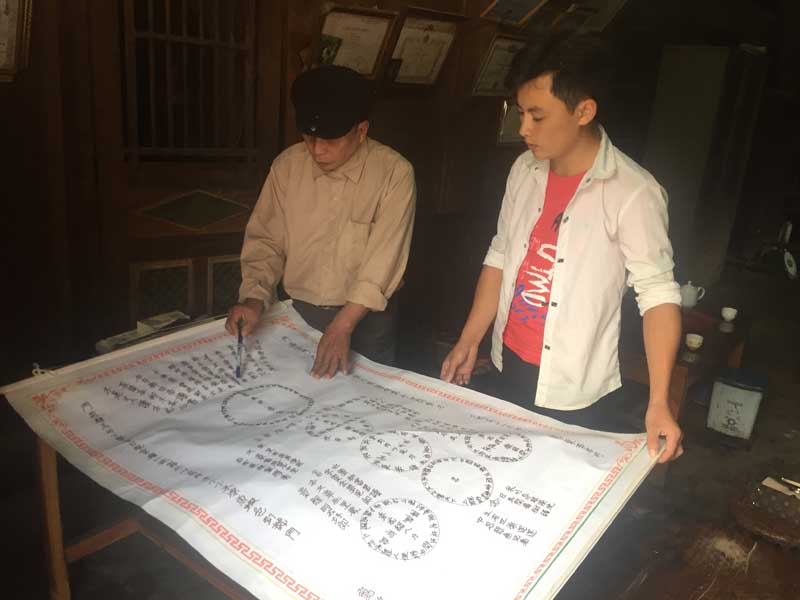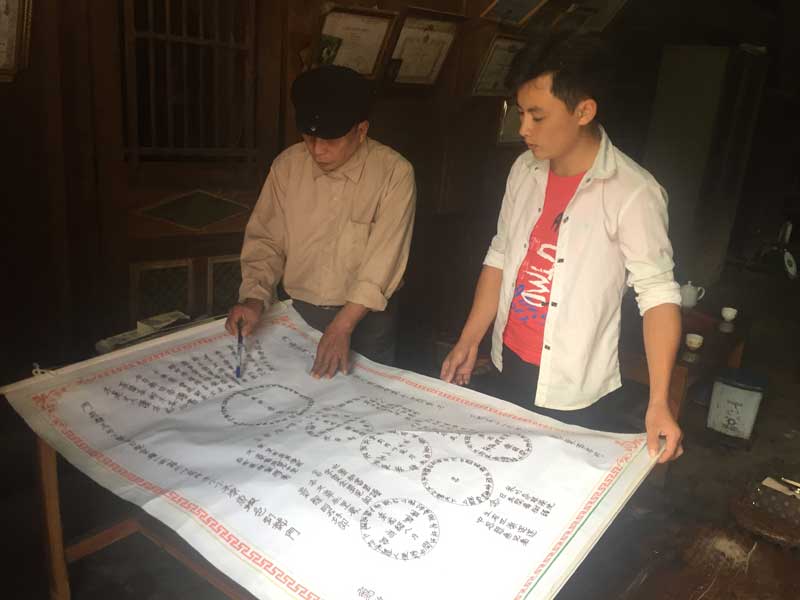
(HBO) - In 2019, 10 artists in Hoa Binh were conferred the title of "Meritorious Artist” by the State President in various forms: social practices and beliefs, folk art performances.
 The meritorious artist, Ly Van Hue in Sung hamlet, Cao Son
commune (Da Bac) is instructing students how to see the traditional calendar
Dao ethnic people.
The meritorious artist, Ly Van Hue in Sung hamlet, Cao Son
commune (Da Bac) is instructing students how to see the traditional calendar
Dao ethnic people.
Keeping the soul of folklore
Being the 7th generation of Bui family in the role of a
shaman, Mr. Bui Van Khan in Phong Phu commune (Tan Lac) is proud and
responsible for taking care of the spirituality for Muong ethnic people in
Muong Bi.
The shaman plays an important role in the spiritual and
religious life of the Muong ethnic people. Born in a traditional family working
as shaman, from an early age, he was heard and watched his grandfather and
father reading Mo songs in the rituals.
For so many generations, Mo words have been passed down by
mouth, so that they do not disappear. He has been collecting, recording and
compiling customs, beliefs and worshiping offerings. In addition, he has taught
his son and some people with qualities and enthusiasm for folklore belief. Many
people have performed rituals such as Tet Shaman, worshiping of the earth,
weddings, etc.
Efforts to preserve and teach the Nom-Dao scripts
With passion and knowledge of Nom-Dao scripts and to
preserve and conserve the culture of Dao ethnic people, he has been collecting,
rewriting and disseminating books on spirituality, customary laws and practices
of the Dao Tien ethnic people for Dao community in the local areas of the
province. The fact that the majority of the Dao people, not only the children
but also many middle-aged and elderly people do not know and write and read the
ancient Nom-Dao of his people has made him feel regret. Therefore, in addition
to collecting and compiling, Mr. Henh has opened free Dao teaching classes for
the neighbors and for Dao ethnic people around. Participating in these class,
the learners cannot only learn about ancient Dao scripts but they also learn
the folk songs of Dao Tien such as: Khia singing, love-response singing,
singing at the rituals of the Dao ethnic people, Cheo dancing, bell dancing,
dancing ...
Words have spread far away, a lot of people in other
communes knowing about these classes have enrolled. From 2008, Mr. Henh has
opened 6 classes for over 200 learners of Dao ethnic people in the communes of
Cao Son, Vua Nua, Doan Ket, Tan Pheo, Hien Luong and Tu Ly. The learners
attending the classes are at all ages, from young children to middle aged
people, elderly people and commune officials.
With an increasingly vibrant and widespread emulation movement aimed at building cultured residential areas and cultured families, Yen Thuy District has been making steady progress toward improving both the material and spiritual well-being of its people, while fostering a civilized, prosperous, beautiful, and progressive community.
Once lacking recreational spaces and community facilities, Residential Group 2 in Quynh Lam Ward (Hoa Binh City) has recently received attention for the construction of a new, spacious, and fully equipped cultural house. The project followed the model of state support combined with public contributions in both labor and funding.
The "All people unite to build cultural life" movement, which has been effectively integrated with Kim Boi district’s socio-economic development goals, is fostering a lively spirit of emulation across local residential areas, hamlets, villages, public agencies, and enterprises. In addition, through the initiative, traditional cultural values are being preserved and promoted, while community solidarity and mutual support in poverty reduction and economic development are being strengthened.
A working delegation of the Hoa Binh provincial People’s Committee led by its Permanent Vice Chairman Nguyen Van Toan on June 11 inspected the progress of a project to build the Mo Muong Cultural Heritage Conservation Space linked to tourism services in Hop Phong commune, Cao Phong district.
Born and growing in the heroic land of Muong Dong, Dinh Thi Kieu Dung, a resident in Bo town of Kim Boi district, in her childhood was nurtured by the sweet lullabies of her grandmother and mother. These melodies deeply imprinted on her soul, becoming an inseparable part of her love for her ethnic group's culture. For over 20 years, this love for her hometown has driven Dung to research, collect, and pass down the cultural values of the Muong people to future generations.
In the final days of May, the Ethnic Art Troupe of Hoa Binh Province organized performances to serve the people in remote, mountainous, and particularly disadvantaged areas within the province. These were not just ordinary artistic shows, but they were the meaningful journeys aimed at spreading cultural values, enhancing the spiritual life of the people and contributing to the preservation of ethnic minority cultural identities.



 The meritorious artist, Ly Van Hue in Sung hamlet, Cao Son
commune (Da Bac) is instructing students how to see the traditional calendar
Dao ethnic people.
The meritorious artist, Ly Van Hue in Sung hamlet, Cao Son
commune (Da Bac) is instructing students how to see the traditional calendar
Dao ethnic people.